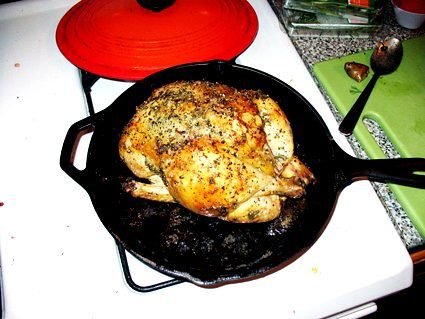The River Cottage Roast Chicken
My go-to roast chicken recipe, that one from Chez Panisse (here's a video I made on how to make it), is such a gut bomb of fat--and fat from just the chicken itself--that any roast chicken recipe that requires the addition of more fat (butter, olive oil) usually provokes my inner Richard Simmons who bursts out in short shorts and says, "You don't need all that fat you fat fat fatty!"
Sometimes, though, you want to gild the lily and such was the case last week when it was time to make our weekly roast chicken (it's pretty much a staple) and I was craving something new. A few days earlier, I'd flipped through the River Cottage Meat Book---
---and memorized the recipe for the River Cottage Roast Chicken. It was simple enough--herbs + garlic + butter rubbed all over the chicken--though it violated my fat fat fatty rule of not adding extra fat. Still, one must try new things, mustn't one? (Please read that last sentence with a British accent.)
The result was dyn-o-mite. Seriously: the butter and the herbs and the garlic penetrated the skin in a powerful way, making it almost too decadent for a weekday night, yet still homey and comforting. This is the chicken to make when you want to experience restaurant-quality roast chicken at home: it's the kind of thing you'd pay a lot of money for out on the town, but in your own kithcen it'll cost you between $15 and $20 and it'll feed two of you.
How do you make it?
Here's how:
The River Cottage Roast Chicken
by Hugh Fearnley-Whittingstall
adapted by me
1. Buy a 3 to 4 pound chicken*. Pat it dry with paper towels---no need to wash it. (Oh, but remove the guts first, that's important. Usually the guts come in a little bag.)
* NOTE: Look for the best chicken you can at the store: organic, free-range, etc. It makes a big difference. (I recently switched from Bell & Evans to Smart Chicken because the latter is free-range and Craig commented that it tasted better without knowing it was a different kind of bird. Just saying!)
2. Soften 7 Tbs of butter (leave it out for an hour or two.)
3. Cut up lots of rosemary and garlic and sage together until it's fine, fine, fine. (About 3 cloves garlic, 3 branches rosemary (off the stem) and 5 to 6 leaves of sage.
4. Mash up the garlic, rosemary, and sage into the butter using a fork. Add salt and pepper too.
5. Now shmear that all over the chicken, getting it on the back side, the legs, the thighs, in the cavity, and ESPECIALLY all over and under the breast. When I say under the breast, I mean make a little flap in the breast skin using your finger and shove some of the butter under there. You'll thank me later.
6. If you're a salty person (and I definitely am) sprinkle some more salt over the chicken. Also grind some more pepper.
7. Pop into a 400 degree oven for 20 minutes. (I put mine in a cast iron skillet, but you can use a roasting pan.) Then lower the heat to 350 and cook another 30 to 40 minutes until it's golden brown and it smells beautiful. Finally, turn off the heat, open the oven door and leave it like that to rest for another 20 minutes (this is a technique from the book, and I think it makes good sense--so the chicken comes to temperature more gradually.)
And that's it! Look how pretty:

Oh and what's that bit you see on the cutting board on the right? That's one of Ina Garten's Dill Fingerling Potatoes, recipe here, picture here:

It's a lovey riff on a classic dinner: chicken and potatoes, Variation #33,825.

Give it a whirl and make the Richard Simmons in your head very, very mad.

